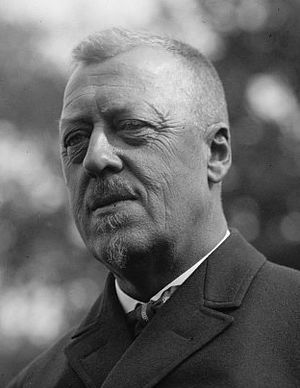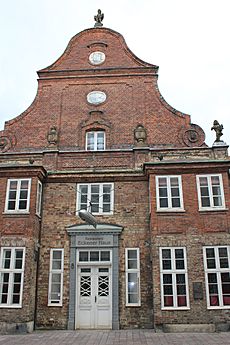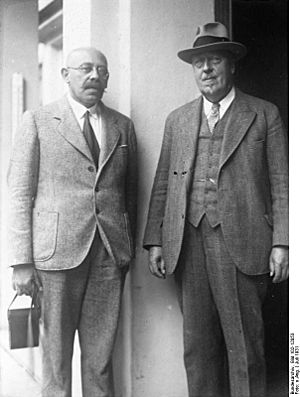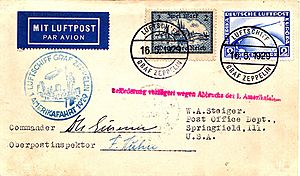Hugo Eckener facts for kids
Hugo Eckener (born August 10, 1868 – died August 14, 1954) was a very important person in the history of airships. He led the Luftschiffbau Zeppelin company between the two World Wars. He was also the main captain of the famous Graf Zeppelin for many of its amazing flights. These flights included the first time an airship flew all the way around the world. This made him one of the most successful airship captains ever. He also helped build some of the best airships of all time. Eckener did not agree with the Nazi government and faced difficulties because of his views.
Contents
Early Life and Career
Hugo Eckener was born in Flensburg, Germany. He was the first child of Johann Christoph Eckener and Anna Lange. When he was young, he enjoyed sailing in the summer and ice skating in the winter. He didn't always focus on school.
However, by 1892, he earned a doctorate degree in psychology from Leipzig University. After his studies, Eckener joined the military for a short time.
Later, Eckener became a journalist and editor. In 1893, he worked for the Flensburger Nachrichten newspaper. He married Johanna Maaß in 1897. He also wrote for the Frankfurter Zeitung newspaper in 1905 and 1906.
Becoming an Airship Pioneer
Eckener was asked to write about the first flights of the Zeppelin airships, LZ 1 and LZ 2. He thought these early airships didn't fly very well. But he admired Count Ferdinand von Zeppelin's hard work and dedication. Count Zeppelin wanted to talk to Eckener because many scientists had criticized his airship plans.
Eckener was so impressed by Count Zeppelin that he agreed to work part-time for the Zeppelin Company in 1908. He became very interested in airships and soon joined the company full-time.
He quickly showed a natural talent for flying airships. He became an airship captain and got his license in 1911. His first flight as captain was on May 16, 1911, in the LZ 8, called Deutschland II. He tried to launch it in strong winds, which pushed the airship into the hangar wall and damaged it. Despite this rocky start, he became a very successful airship pilot.
World War I and Leading the Zeppelin Company
During World War I, Eckener was very important for training most of Germany's airship pilots. He wanted to fly missions, but he was not allowed to. This was because his skills as an instructor were too valuable.
After the war, Count Zeppelin passed away in 1917. Eckener then took over as the head of the Zeppelin Company. There was a disagreement with the company's business manager, Alfred Colsman. Colsman wanted to stop building airships and make other products. But Eckener fought to keep the Zeppelin factory in Friedrichshafen building airships. Colsman left the company soon after.
The Treaty of Versailles, signed after World War I, stopped Germany from building very large airships. These large airships were needed for profitable flights across the Atlantic Ocean, which was Eckener's goal. However, Eckener worked hard to convince the U.S. and German governments. He got permission for the company to build LZ 126. This airship was later named the USS Los Angeles (ZR-3). It was built for the United States Navy as part of Germany's war payments. Eckener himself captained the airship on its flight to Lakehurst, New Jersey. The Los Angeles became the longest-serving rigid airship in the U.S. Navy.
The Golden Age of Airships
The German government was short on money. So, Eckener and his team started a tour across the country, giving lectures to raise money. They wanted to build the Graf Zeppelin. This airship became the most successful rigid airship ever built.
The Graf Zeppelin's first flight to America was full of excitement. Near Bermuda, a severe storm almost destroyed the airship. Fabric was ripped off one of its fins. Eckener's excellent piloting skills saved the ship. His son, Knut Eckener, and other crew members bravely climbed out onto the fin to fix the damage. When they arrived in America, Eckener and his crew were welcomed with a ticker tape parade in New York City.
Eckener was the captain for most of the Graf Zeppelin's record-breaking flights. These included the first intercontinental passenger airship flight in 1928. He also captained the 1929 flight around the world. This was the only time an airship completed such a flight, and only the second time for any aircraft. In 1931, he led the airship on an amazing Arctic flight.
Eckener was also very good at getting public attention. He used the Graf Zeppelin to show off German engineering and pride. After these flights, people saw Eckener as a national hero. In the early 1930s, he was one of the most famous and respected people in Germany.
In the 1932 presidential election, some leaders wanted Eckener to run against Adolf Hitler. But Eckener decided not to run when Paul von Hindenburg chose to seek another term. However, the Nazi Party was already angry about the idea of Eckener running.
Challenges with the Nazi Government
The Nazis came to power in January 1933. A plan to arrest Eckener in 1933 was stopped by Hindenburg. Hitler and Eckener met only once, in July 1933, but they barely spoke. Eckener openly disliked the Nazis and worried about the bad things he saw coming. He often criticized the government. He also refused to let the Nazis use the large airship hangars in Frankfurt for their meetings. Eventually, the Nazis declared Eckener to be an enemy of the state. His name was no longer allowed to appear in newspapers.
In the 1930s, the Nazi government took control of the Zeppelin company. They renamed it Deutsche Zeppelin-Reederei GmbH (DZR). The Nazis pushed Eckener aside. They put people in charge who would follow their orders. These new airship leaders did not always follow Eckener's safety rules. For example, the first trip of the Hindenburg almost ended in disaster. Captain Ernst A. Lehmann flew the ship in strong winds for a Nazi propaganda flight. The ship was damaged, and Eckener argued with Lehmann and the Nazi propaganda ministry.
Hugo Eckener always made safety his top priority. Under his leadership, the Zeppelin company had a perfect safety record. No passenger was ever seriously hurt on any of the millions of miles flown by rigid airships. This perfect record lasted until the Hindenburg disaster in 1937. Eckener was in Graz, Austria when he heard about the Hindenburg accident on May 6, 1937. In the official investigation, he believed that a static spark caused hydrogen to leak and catch fire in the back of the ship. He thought the leak happened because a sharp turn broke a wire, which then tore open a gas cell.
After the Hindenburg was destroyed, the nearly finished LZ-130 Graf Zeppelin II was changed to use helium instead of hydrogen. However, America would not provide the helium because of political reasons. So, the ship never started commercial service. But under Captain Albert Sammt, who survived the Hindenburg fire, the ship flew a secret mission. It went off the coast of Great Britain to check their radar defenses. By this time, Eckener had little influence on the Zeppelin Company.
After World War II
Eckener survived World War II despite his disagreements with the Nazis. After the war, he worked with the Goodyear Zeppelin Corporation. They planned to build large rigid airships, but this project did not happen.
In 1945, Eckener helped start the Südkurier regional newspaper. He also began writing about cooperation between Germany and France. In November 1945, Eckener was accused of working with Nazi Germany. In 1947, the French authorities fined him 100,000 Reichsmark. Many important people spoke up for Eckener. In July 1948, the judgment was overturned, and Eckener was cleared.
Eckener's hometown of Flensburg had a council that mostly wanted to join Denmark after 1945. Eckener remained active in local politics. He campaigned for a German majority in Flensburg. In 1951, he gave a powerful speech, warning against narrow-mindedness in border issues.
Hugo Eckener passed away in Friedrichshafen on August 14, 1954, shortly after his 86th birthday.
Legacy

Eckener was behind many new developments in aviation. Most notably, he helped create the trans-Atlantic passenger services offered by the Graf Zeppelin and Hindenburg airships.
Since his death, airship fans and historians remember his achievements. The town of Friedrichshafen, where the Graf Zeppelin often returned in triumph, has honored him. They named a large new conference center after him.
See also
 In Spanish: Hugo Eckener para niños
In Spanish: Hugo Eckener para niños
- List of Zeppelins





